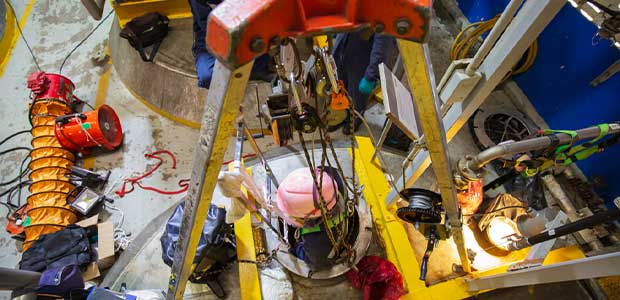
Training for Permit Space Entry: A Team Effort
Rescue teams must have proper training and equipment to perform a rescue.
- By Mark H. Stromme
- May 01, 2022
Safety professionals understand the importance of following OSHA’s permit-required confined space training requirements. It’s the employer’s responsibility to ensure these team members are trained according to 29 CFR 1910.146.
Training is required for all affected employees. That means all members of the entry team, which include the authorized entrant, attendant and entry supervisor. Training must provide the affected employees with the appropriate understanding, skills and knowledge to perform their jobs safely in a permit space.
Each team member must receive training on their responsibilities, as well as training on the hazards of the permit space. Members must be trained before the first entry and as duties or hazards change.
OSHA is also very specific regarding the training of rescue teams. For the safety of the entry team, a rescue team must be available in an emergency. Whether the rescue team is an on-site group of employees with specialized training, or an outside agency, such as a local fire department, the rescue team must be aware of all potential hazards and have the proper training and equipment to perform a rescue in the workplace’s permit spaces.
Entry Team
If work needs to be done within a permit space, it will be performed by an entry team. Each member of the team has a distinct role:
- The authorized entrant goes into the permit space to perform assigned work;
- The attendant remains outside the space and monitors the entrant; and
- The entry supervisor reviews and signs the entry permit, authorizes entry and supervises the entry operation.
Depending on the work that needs to be done, there may be multiple authorized entrants during an entry. And, the entry supervisor can also be an authorized entrant or attendant if he or she has been properly trained to do so. Most importantly, the entry team must work together to ensure a safe entry.
Authorized Entrant
During a permit space entry operation, the authorized entrant must:
- Be aware of the permit space hazards, including the signs, symptoms and effects of exposure (e.g., dizziness, sleepiness, breathing difficulties, confusion);
- Know how to properly use personal protective equipment (PPE) and other equipment used during the entry operation;
- Communicate any condition changes in the permit space;
- Keep the attendant informed of their status during entry;
- Evacuate immediately if they experience any warning signs or symptoms of exposure, a prohibited condition is detected, an evacuation alarm is activated or if ordered to do so by the attendant.
Attendant
During a permit space entry operation, the attendant must:
- Warn unauthorized persons approaching the permit space to stay away;
- Advise unauthorized persons that have entered the permit space to exit immediately;
- Perform no duties that might interfere with their ability to assess and protect authorized entrants;
- Be familiar with all potential hazards in and around the permit space;
- Know how to use testing, monitoring, communication and non-entry rescue equipment;
- Monitor activities inside and outside the space;
- Monitor the entrant at all times during the entry;
- Maintain communication with the entrant; *Recognize the behavioral effects of hazard exposure in the entrant (e.g., lack of coordination, drowsiness, slurred speech, confusion, non-response);
- Maintain an accurate count of the entrants when there are multiple entrants;
- Inform the authorized entrant and the entry supervisor if unauthorized employees enter the permit space;
- Order an evacuation of the space if they detect a prohibited condition, behavioral effects of hazardous exposure in the entrant, a dangerous situation outside of the space, or if they cannot perform all of their duties and have not been relieved;
- Summon a rescue team or emergency services as soon as assistance is needed;
- Perform a non-entry rescue; and
- Remain outside the permit space until the operation is complete or until they’re relieved by another trained attendant.
Entry Supervisor
During a permit space entry operation, the entry supervisor must:
- Review the entry permit,
- Sign the entry permit to authorize entry,
- Be aware of the hazards of the permit space and consequences of exposure,
- Verify all tests specified by the permit have been conducted,
- Verify all procedures and equipment are in place,
- Verify rescue services are available,
- Record any problems encountered during the entry on the entry permit,
- Cancel the entry permit when a condition that is not allowed arises in or near the permit space,
- Cancel and file the entry permit when entry operations have been completed,
- Remove all unauthorized personnel, and
- Pass duties to another supervisor during an operation if needed.
Over and over, experience has demonstrated permit spaces are dangerous places with the potential to cause very serious injury, or worse. In fact, every year OSHA is faced with investigating permit space fatalities.
Training is important and required for all affected employees—the authorized entrant, attendant and entry supervisor. Provide the affected employees with the appropriate understanding, skills and knowledge to perform their jobs safely in a permit space.
This article originally appeared in the May 2022 issue of Occupational Health & Safety.